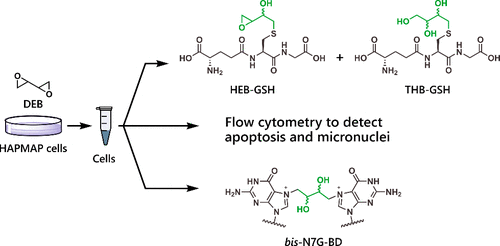当前位置:
X-MOL 学术
›
Chem. Res. Toxicol.
›
论文详情
Our official English website, www.x-mol.net, welcomes your feedback! (Note: you will need to create a separate account there.)
Effects of GSTT1 Genotype on the Detoxification of 1,3-Butadiene Derived Diepoxide and Formation of Promutagenic DNA–DNA Cross-Links in Human Hapmap Cell Lines
Chemical Research in Toxicology ( IF 4.1 ) Pub Date : 2020-12-31 , DOI: 10.1021/acs.chemrestox.0c00376 Gunnar Boysen 1, 2, 3 , Rashi Arora 4 , Amanda Degner 1, 4 , Karin R Vevang 5 , Christopher Chao 1 , Freddys Rodriguez 1 , Scott J Walmsley 4, 6 , Luke Erber 1 , Natalia Y Tretyakova 1, 4 , Lisa A Peterson 4, 5
Chemical Research in Toxicology ( IF 4.1 ) Pub Date : 2020-12-31 , DOI: 10.1021/acs.chemrestox.0c00376 Gunnar Boysen 1, 2, 3 , Rashi Arora 4 , Amanda Degner 1, 4 , Karin R Vevang 5 , Christopher Chao 1 , Freddys Rodriguez 1 , Scott J Walmsley 4, 6 , Luke Erber 1 , Natalia Y Tretyakova 1, 4 , Lisa A Peterson 4, 5
Affiliation

|
Smoking is a leading cause of lung cancer, accounting for 81% of lung cancer cases. Tobacco smoke contains over 5000 compounds, of which more than 70 have been classified as human carcinogens. Of the many tobacco smoke constituents, 1,3-butadiene (BD) has a high cancer risk index due to its tumorigenic potency and its abundance in cigarette smoke. The carcinogenicity of BD has been attributed to the formation of several epoxide metabolites, of which 1,2,3,4-diepoxybutane (DEB) is the most toxic and mutagenic. DEB is formed by two oxidation reactions carried out by cytochrome P450 monooxygenases, mainly CYP2E1. Glutathione-S-transferase theta 1 (GSTT1) facilitates the conjugation of DEB to glutathione as the first step of its detoxification and subsequent elimination via the mercapturic acid pathway. Human biomonitoring studies have revealed a strong association between GSTT1 copy number and urinary concentrations of BD-mercapturic acids, suggesting that it plays an important role in the metabolism of BD. To determine the extent that GSTT1 genotype affects the susceptibility of individuals to the toxic and genotoxic properties of DEB, GSTT1 negative and GSTT1 positive HapMap lymphoblastoid cell lines were treated with DEB, and the extent of apoptosis and micronuclei (MN) formation was assessed. These toxicological end points were compared to the formation of DEB-GSH conjugates and 1,4-bis-(guan-7-yl)-2,3-butanediol (bis-N7G-BD) DNA–DNA cross-links. GSTT1 negative cell lines were more sensitive to DEB-induced apoptosis as compared to GSTT1 positive cell lines. Consistent with the protective effect of GSH conjugation against DEB-derived apoptosis, GSTT1 positive cell lines formed significantly more DEB-GSH conjugate than GSTT1 negative cell lines. However, GSTT1 genotype did not affect formation of MN or bis-N7G-BD cross-links. These results indicate that GSTT1 genotype significantly influences BD metabolism and acute toxicity.
中文翻译:

GSTT1 基因型对人类 Hapmap 细胞系中 1,3-丁二烯衍生的二环氧化物的解毒和促突变 DNA-DNA 交联形成的影响
吸烟是肺癌的主要原因,占肺癌病例的 81%。烟草烟雾中含有5000多种化合物,其中70多种已被列为人类致癌物。在许多烟草烟雾成分中,1,3-丁二烯 (BD) 具有较高的癌症风险指数,因为它具有致瘤能力,并且在香烟烟雾中含量丰富。BD 的致癌性归因于几种环氧化物代谢物的形成,其中 1,2,3,4-二环氧丁烷 (DEB) 毒性和致突变性最强。DEB 由细胞色素 P450 单加氧酶(主要是 CYP2E1)进行的两个氧化反应形成。谷胱甘肽-S-转移酶θ1 (GSTT1) 促进 DEB 与谷胱甘肽的结合,作为其解毒和随后通过巯基酸途径消除的第一步。人体生物监测研究揭示了GSTT1拷贝数与尿中 BD-巯基酸浓度之间的强关联,表明它在 BD 的代谢中起重要作用。确定GSTT1基因型对个体对 DEB、GSTT1阴性和GSTT1的毒性和基因毒性特性的易感性的影响程度用 DEB 处理阳性 HapMap 淋巴母细胞系,并评估细胞凋亡和微核 (MN) 形成的程度。将这些毒理学终点与 DEB-GSH 缀合物和 1,4-双-(guan-7-yl)-2,3-丁二醇 (双-N7G-BD) DNA-DNA 交联的形成进行了比较。与GSTT1阳性细胞系相比,GSTT1 阴性细胞系对 DEB 诱导的细胞凋亡更敏感。与 GSH 偶联物对 DEB 衍生的细胞凋亡的保护作用一致,GSTT1阳性细胞系形成的 DEB-GSH 偶联物明显多于GSTT1阴性细胞系。然而,GSTT1基因型不影响 MN 的形成或bis -N7G-BD 交联。这些结果表明GSTT1基因型显着影响BD代谢和急性毒性。
更新日期:2021-01-18
中文翻译:

GSTT1 基因型对人类 Hapmap 细胞系中 1,3-丁二烯衍生的二环氧化物的解毒和促突变 DNA-DNA 交联形成的影响
吸烟是肺癌的主要原因,占肺癌病例的 81%。烟草烟雾中含有5000多种化合物,其中70多种已被列为人类致癌物。在许多烟草烟雾成分中,1,3-丁二烯 (BD) 具有较高的癌症风险指数,因为它具有致瘤能力,并且在香烟烟雾中含量丰富。BD 的致癌性归因于几种环氧化物代谢物的形成,其中 1,2,3,4-二环氧丁烷 (DEB) 毒性和致突变性最强。DEB 由细胞色素 P450 单加氧酶(主要是 CYP2E1)进行的两个氧化反应形成。谷胱甘肽-S-转移酶θ1 (GSTT1) 促进 DEB 与谷胱甘肽的结合,作为其解毒和随后通过巯基酸途径消除的第一步。人体生物监测研究揭示了GSTT1拷贝数与尿中 BD-巯基酸浓度之间的强关联,表明它在 BD 的代谢中起重要作用。确定GSTT1基因型对个体对 DEB、GSTT1阴性和GSTT1的毒性和基因毒性特性的易感性的影响程度用 DEB 处理阳性 HapMap 淋巴母细胞系,并评估细胞凋亡和微核 (MN) 形成的程度。将这些毒理学终点与 DEB-GSH 缀合物和 1,4-双-(guan-7-yl)-2,3-丁二醇 (双-N7G-BD) DNA-DNA 交联的形成进行了比较。与GSTT1阳性细胞系相比,GSTT1 阴性细胞系对 DEB 诱导的细胞凋亡更敏感。与 GSH 偶联物对 DEB 衍生的细胞凋亡的保护作用一致,GSTT1阳性细胞系形成的 DEB-GSH 偶联物明显多于GSTT1阴性细胞系。然而,GSTT1基因型不影响 MN 的形成或bis -N7G-BD 交联。这些结果表明GSTT1基因型显着影响BD代谢和急性毒性。



























 京公网安备 11010802027423号
京公网安备 11010802027423号